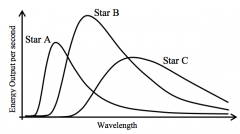![]()
![]()
![]()
Use LEFT and RIGHT arrow keys to navigate between flashcards;
Use UP and DOWN arrow keys to flip the card;
H to show hint;
A reads text to speech;
11 Cards in this Set
- Front
- Back
|
Say you see in your telescope star A and it looks blue and star B appears red. Assume no Doppler shifts. What can you conclude? |
Star A has a hotter surface temperature than star B. |
|
|
The star Antares and Mimosa each have the same luminosity. Antares is cooler than Mimosa. Which star is larger? |
Antares. |
|
|
Object A has a larger redshift than object B. What can we conclude? |
Object A is moving away from us faster than object B. |
|
|
Let's say in the laboratory a particular transition in the hydrogen atom occurs at a wavelength of light of 486 nanometers (nm). But we observe a spectrum of a star that shows the same hydrogen feature at 485.1 nm. What can we conclude? |
The star is moving toward us. |
|
|
True or False: A lump of lead is heated to 1000 deg. Celsius. Another lump of lead twice as large is heated to 500 deg. Celsius. The hotter lump appears bluer than the cooler lump. |
True. |
|
|
The spectra of most galaxies show redshifts. This means that their spectral lines... |
have wavelengths longer than normal. |
|
|
The star Vega is much hotter than the Sun. Which one of the following is therefore true. |
Vega emits more infrared radiation and more ultraviolet radiation than the Sun. |
|
|
Studying a spectrum from a star can tell us a lot. Which one of the following statements is false? 1.The peak of the star's emission tells us its temperature. Hotter stars peak at shorter (bluer) wavelengths. 3. We can identify chemical elements present in the star by recognizing patters of spectral lines. 4. We can look at Doppler shifts of the spectrum to determine a star's speed. |
The total amount of light tells us the star's radius. |
|

The figure shows the blackbody spectrum for 3 stars. Which star has the highest temperature? |
Star A. |
|
|
The luminosity of an object is independent of its distance from you. |
True. |
|
|
At what temperature does water boil? |
373 K |

